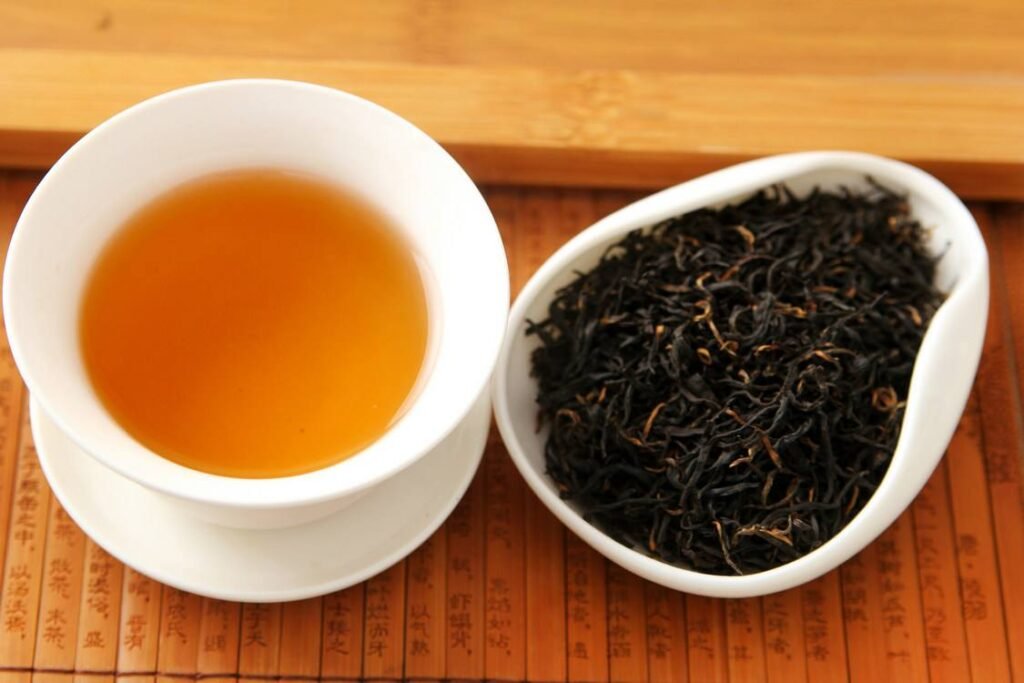Black tea, known as “Red Tea” (Hong Cha) in China due to the reddish color of its brewed liquor, is one of the six major tea categories in Chinese tea culture. Fully oxidized and rich in character, Chinese black tea offers a diverse range of flavors and a fascinating story that spans centuries and continents.
What Is Chinese Black Tea?
Chinese black tea refers to fully oxidized tea made primarily from the Camellia sinensis plant. Unlike green tea (non-oxidized) or oolong (semi-oxidized), black tea undergoes a full oxidation process that transforms the color, flavor, and aroma of the leaves. The name “black tea” is used in the West to describe these darkened leaves, but in China, the beverage is called red tea because of its vibrant infusion.
Famous black tea regions include Fujian, Yunnan, Sichuan, and Guangdong, with spring and autumn being the best harvesting seasons for premium-quality leaves.
A Brief History: How Chinese Black Tea Began
The invention of black tea dates back to the mid-17th century, during the late Ming or early Qing Dynasty. Legend has it that an army passing through Fujian Province camped near a tea factory in the Wuyi Mountains, delaying production. To speed up processing and avoid spoilage, a local tea maker dried the leaves over pinewood smoke, which produced a reddish brew with a distinctive smoky-fruity aroma.
Thus, Lapsang Souchong was born — the first recorded black tea in the world and the prototype for many others that followed. This innovation gave rise to a new class of teas appreciated both in China and eventually across the globe.
Red Tea vs. Black Tea: Clearing the Confusion
In Western terminology, “black tea” refers to oxidized teas. But in China:
- Red Tea (Hong Cha) = Fully oxidized teas like Dianhong, Keemun, and Lapsang Souchong
- Black Tea (Hei Cha) = Post-fermented aged teas such as Pu-erh, which continue fermenting after processing
This naming difference has caused centuries of confusion, especially during early trade between China and Europe. Western traders noticed the dark leaves and called them “black tea,” while the Chinese focused on the color of the infusion.
How Chinese Black Tea Is Made
The process of making black tea involves several precise steps:
- Withering – Fresh leaves lose moisture
- Rolling – To break leaf cells and start oxidation
- Oxidation – Controlled exposure to air, which darkens the leaves and develops flavor compounds
- Drying – Heat is applied to stop oxidation and preserve the tea
In some cases, like Lapsang Souchong, pinewood smoke is used during drying to add unique flavor complexity. The oxidation process naturally generates theaflavins and thearubigins, antioxidant compounds responsible for the tea’s color and taste.
Famous Varieties of Chinese Black Tea
- Lapsang Souchong: Pine-smoked, bold and aromatic
- Keemun: Floral, malty, often used in English Breakfast blends
- Dianhong (Yunnan Black Tea): Rich, honeyed, full-bodied
- Jin Jun Mei: Delicate buds, sweet and smooth
Each variety has its own terroir and flavor profile, shaped by altitude, climate, soil, and crafting methods.
Health Benefits of Chinese Black Tea
While traditional Chinese medicine has long praised black tea for its wellness properties, modern science takes a more cautious approach. However, black tea does contain bioactive compounds that may provide certain health benefits:
- Flavonoids & theaflavins: Antioxidants that may support heart and cellular health
- Fluoride: May contribute to dental wellness
- Natural stimulants: Can improve alertness and reduce fatigue
- Bone-supporting minerals: Like potassium and manganese
- Traditional claims: Digestive aid, fat metabolism support, and blood circulation enhancement
🔎 Note: These effects vary among individuals, and while many tea drinkers feel benefits, scientific consensus is limited. Enjoy tea for its rich flavor and calming ritual, rather than as a medicinal substitute.
Caffeine in Black Tea: What You Need to Know
The caffeine content in tea varies widely depending on:
- Leaf type and grade
- Brewing method
- Steeping time and temperature
According to the UK Food Standards Agency (2004):
- Chinese Black Tea (8 oz): ~30–50 mg caffeine
- Chinese Green Tea: ~30–70 mg caffeine
- Instant Coffee: ~54 mg
- Ground Coffee: ~95–140 mg
✅ In general, Chinese black teas (from Camellia sinensis) contain less caffeine than Indian black teas made from Camellia assamica.
✅ Shorter brews in Gongfu Cha style significantly reduce caffeine intake.
Tip: Discarding the first rinse (commonly done in Chinese tea culture) may remove up to 20% of the caffeine, as it is highly water-soluble.
How to Store Chinese Black Tea
Proper storage helps maintain freshness and enhances aging potential. Follow these tips:
- Use airtight porcelain or glass containers
- Store in a cool, dry, odor-free place (avoid kitchens)
- Avoid direct sunlight or humidity
- Whole-leaf black teas often improve with age
A Global Legacy of Chinese Black Tea
By the late 19th century, British colonialists introduced black tea cultivation in India using smuggled Chinese tea plants and techniques. However, Indian tea producers later favored native assamica varieties due to their higher yields and caffeine content.
Mechanized rolling and cutting machines further revolutionized black tea into a mass-market product. Still, discerning tea lovers today are rediscovering the complexity, elegance, and heritage of traditional Chinese black teas — a world away from the broken-leaf tea bags common in the West.
